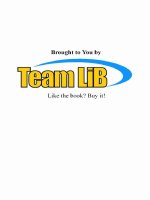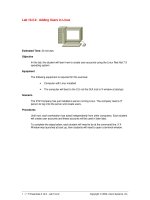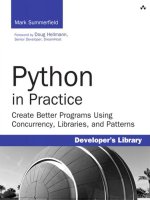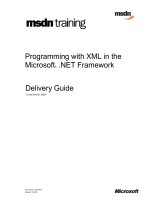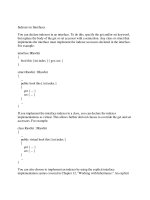REST in Practice pdf
Bạn đang xem bản rút gọn của tài liệu. Xem và tải ngay bản đầy đủ của tài liệu tại đây (12.23 MB, 448 trang )
Advance Praise for REST in Practice
“Jim, Savas, and Ian manage to make the notoriously abstract concepts behind RESTful in-
tegration useful and applicable in day-to-day work, as well as easy to understand. If you’re
looking into how to do web-based integration simply and effectively, this is where you
should start.”
—Mark Nottingham
Principal Technical Yahoo!, Yahoo
“It is no coincidence that since Jim, Savas, and Ian started their frequent presentations and
writings on the importance and applicability of hypermedia in distributed systems, the land-
scape of REST’s practical usage started to change. Restfulie is an example how influential their
ideas have been.”
—Guilherme Silveira
Tech Lead at Caelum and Restfulie Project Leader
“While there are by now many books that describe basic REST and HTTP principles, this book
raises the bar by exploiting the web architecture’s benefits for more advanced use cases, such
as hypermedia-driven processes. A perfect mix of theory and practice.”
—Stefan Tilkov
CEO, InnoQ
“REST is different from traditional approaches to application design and development. It’s
important to clearly understand REST and build on successful examples. REST in Practice meets
this need head-on. Its authors are all excellent technologists and communicators, and have
done a great job tackling this challenging subject.”
—Eric Newcomer
Chief Architect, Investment Banking Division, Credit Suisse
“REST in Practice unifies a grounded, pragmatic approach to building real-world services with
crystal-clear explanations of higher-level abstractions. The result is a book that teaches you
both how and why to develop services with flexible, negotiable, discoverable interfaces.”
—Michael T. Nygard
Author of Release It!
“REST can appear confusing and inaccessible, filled with jargon and with precious few really
good examples. Luckily, this book does a superb job of taking the difficult and misunderstood
parts of REST and describing them so they appear both simple and obvious. Along the way, it
also shows how to build upon REST and the Web to solve real-world problems.”
—Colin Jack
Senior Software Developer
REST in Practice
Jim Webber, Savas Parastatidis, and Ian Robinson
Beijing · Cambridge · Farnham · Köln · Sebastopol · Tokyo
REST in Practice
by Jim Webber, Savas Parastatidis, and Ian Robinson
Copyright © 2010 Jim Webber, Savas Parastatidis, and Ian Robinson. All rights reserved.
Printed in the United States of America.
Published by O’Reilly Media, Inc., 1005 Gravenstein Highway North, Sebastopol, CA 95472.
O’Reilly books may be purchased for educational, business, or sales promotional use. Online
editions are also available for most titles (). For more information,
contact our corporate/institutional sales department: (800) 998-9938 or
Editor: Simon St.Laurent
Production Editor: Rachel Monaghan
Copyeditor: Audrey Doyle
Proofreader: Rachel Monaghan
Production Services:
Newgen North America
Indexer: Lucie Haskins
Cover Designer: Karen Montgomery
Interior Designer: Ron Bilodeau
Illustrator: Robert Romano
Printing History:
September 2010: First Edition.
The O’Reilly logo is a registered trademark of O’Reilly Media, Inc., REST in Practice, the cover
image, and related trade dress are trademarks of O’Reilly Media, Inc.
Many of the designations used by manufacturers and sellers to distinguish their products are
claimed as trademarks. Where those designations appear in this book, and O’Reilly Media, Inc.,
was aware of a trademark claim, the designations have been printed in caps or initial caps.
While every precaution has been taken in the preparation of this book, the publisher and au-
thors assume no responsibility for errors or omissions, or for damages resulting from the use of
the information contained herein.
ISBN: 978-0-596-80582-1
[M]
v
C O N T E N T S
Foreword . . . . . . . . . . . . . . . . . . . . . . . . . . . . . . ix
Preface . . . . . . . . . . . . . . . . . . . . . . . . . . . . . . . xi
1 The Web As a Platform for Building Distributed Systems . . 1
Architecture of the Web 2
Thinking in Resources 4
From the Web Architecture to the REST Architectural Style 12
The Web As an Application Platform 15
Web Friendliness and the Richardson Maturity Model 18
GET on Board 20
2 Introducing Restbucks: How to GET a Coffee,
Web Style . . . . . . . . . . . . . . . . . . . . . . . . . . . . . 21
Restbucks: A Little Coffee Shop with Global Ambitions 22
Toolbox 27
Here Comes the Web 30
3 Basic Web Integration . . . . . . . . . . . . . . . . . . . . . 31
Lose Weight, Feel Great! 31
A Simple Coffee Ordering System 32
URI Templates 35
URI Tunneling 37
POX: Plain Old XML over HTTP 42
We Are Just Getting Started 54
4 CRUD Web Services . . . . . . . . . . . . . . . . . . . . . . 55
Modeling Orders As Resources 55
Building CRUD Services 57
Aligning Resource State 78
Consuming CRUD Services 83
Consuming Services Automatically with WADL 86
CRUD Is Good, but It’s Not Great 90
vi
CONTENTS
5 Hypermedia Services . . . . . . . . . . . . . . . . . . . . . . 93
The Hypermedia Tenet 93
Hypermedia Formats 97
Contracts 108
Hypermedia Protocols 112
Implementing a Hypermedia Service 128
Building the Ordering Service in Java 128
Building the Ordering Service in .NET 140
Ready, Set, Action 152
6 Scaling Out . . . . . . . . . . . . . . . . . . . . . . . . . . . . 155
GET Back to Basics 155
Caching 157
Making Content Cacheable 161
Implementing Caching in .NET 167
Consistency 171
Extending Freshness 179
Stay Fresh 183
7 The Atom Syndication Format . . . . . . . . . . . . . . . . . 185
The Format 185
Common Uses for Atom 188
Using Atom for Event-Driven Systems 189
Building an Atom Service in Java 207
Building an Atom Service in .NET 219
Atom Everywhere? 234
After the Event 236
8 Atom Publishing Protocol . . . . . . . . . . . . . . . . . . . 237
Atom Publishing Protocol 238
Implementing Order Fulfillment Using AtomPub 249
Implementing AtomPub in .NET 268
A Versatile Protocol 283
9 Web Security . . . . . . . . . . . . . . . . . . . . . . . . . . . 285
HTTP Security Essentials 286
Identity and the OpenID Protocol 295
The OAuth Protocol 315
Service Hacks and Defenses 339
Final Thoughts 349
vii
CONTENTS
10 Semantics . . . . . . . . . . . . . . . . . . . . . . . . . . . . 351
Syntax Versus Semantics 351
Structure and Representation of Information 352
The Semantic Web 357
Microformats 372
Linked Data and the Web 373
Guidance 374
11 The Web and WS-*. . . . . . . . . . . . . . . . . . . . . . . . 375
Are Web Services Evil? 375
SOAP: The Whole Truth 376
WSDL: Just Another Object IDL 380
Two Wrongs Don’t Make a Right 386
Secure, Reliable, Transacted 387
A Requiem for Web Services? 405
12 Building the Case for the Web . . . . . . . . . . . . . . . . 407
No More Silver Bullets 407
Building and Running Web-Based Services 407
No Architecture Without Measurement 409
Selling the Web 412
Go Forth and Build 414
Index . . . . . . . . . . . . . . . . . . . . . . . . . . . . . . . . 415
ix
Foreword
FROM THE VERY START OF WHEN I GOT INVOLVED IN COMPUTING, there’s been
the desire to have software systems designed as components that can be freely com-
bined. The wide-scale connectivity of the Internet fueled this desire, and added the
desire to have components operate over networks that introduce issues of latency
and unknown reliability. In this world many systems have been tried, and many
have failed—usually with a whimper.
A great example of success is the World Wide Web. Its success has penetrated both
business operations and popular culture. It provides opportunities for people to pull
together information from many sources, with hardly any prearranged collaboration—
and at a global scale.
The Web, as we currently know it, isn’t the be-all and end-all of computing, but many
people believe it offers an important lesson on how to construct systems of networked
components. Many people take advantage of its protocol, HTTP, to connect systems.
But some people think we should go further, using HTTP not as a convenient tunnel,
but to embrace the way the Web works as a foundation for systems collaboration.
This thinking gathers together under the name of “REST.” It refers to Roy Fielding’s
PhD thesis, which is far more often referred to than it is read. There is a growing
notion that following the principles of REST offers a fruitful path to making networked
components work, one that is built upon the success of the Web itself.
x
FOREWORD
That vision is attractive, but there is much to be done to reach it. We have to take the
principles of REST and see how to apply them to the everyday problems of systems
integration. This is the task the authors of this book have taken on: to take REST from
an attractive vision to implemented systems. They’ve done much to teach me about
thinking in resources, how to use HTTP idioms, and the importance of hypermedia
controls. As a result, this book will give you a thorough grounding in applying the core
elements of RESTful thinking.
As we all should know, REST is not the answer to all questions. There are many situa-
tions where a REST approach is an appropriate approach, but many where it is not. As
it’s early days in using this style for integration problems, we are still feeling our way
around these boundaries. But in order to explore these boundaries properly, it’s vital
to have a proper understanding of what REST is about. Without that, you run the risk
of trying pseudo-REST and drawing the wrong conclusions. This book can help you
avoid that fate.
—Martin Fowler
August 2010
xi
Preface
THE WEB HAS REVOLUTIONIZED THE WAY WE ACCESS AND SHARE INFORMATION. In
just two decades, it has become the global platform for delivering and consuming services.
The pervasiveness and ubiquity of the Web stems from the way it combines architec-
tural simplicity with a small set of widely accepted technologies. The Web provides
scalability, security, and reliability for those systems that embrace its simple tenets, and
it does so using commodity tools and platforms.
Our goal in this book is twofold: to demystify the Web as an application platform and
to showcase how web architecture can be applied to common enterprise computing
problems. Throughout the chapters, we make it a point to demonstrate how services
can leverage the Web both inside and outside enterprise boundaries. Our vision is of
an information platform that is open and available to other systems, which eschews
integration in favor of composition, and yet implements valuable business behaviors: a
distributed, hypermedia-driven application platform.
You don’t have to know REST or HTTP in detail in order to understand this book. We’ll
take you from simple integration through to sophisticated business protocols, all with
detailed code examples that you can adapt for your own ends.
Should I Read This Book?
Like most of us, you’re probably already building something that feeds into the Web, and
you’ve probably used tools and patterns for the Web that seem pretty useful. Then you’ve
tackled typical enterprise problems and wondered why it can’t be as nice as the web stuff.
xii
PREFACE
You’re seeing the benefits of the Web all around and you start to question whether
your enterprise’s expensive middleware offers a good return on investment, or
whether it will ever scale to meet your users’ demands.
You might be a developer who wants to understand the Web’s principles in more
detail, and likes to learn through code examples. You’ve heard terms such as URIs,
HTTP, and Atom, and you want to learn more about them, including the type of sup-
port you can get from popular programming platforms.
You may even be an enthusiast who has heard about REST and wants to know what
it is all about. You want to learn more about “hypermedia” and the REST architectural
style so that you can build resource-oriented systems and implement sophisticated
business protocols atop the Web.
This book will help.
Should I Skip This Book?
If you are looking to learn how to design websites or how to write JavaScript applica-
tions, this book will not offer you much, though there’s plenty for competent AJAX
developers to leverage from our approach to building backend services.
If you are looking to build mashups or systems for people to use directly, this book is
probably not for you. We’ve focused on machine-to-machine interactions. In fact, this
book is full of machines talking to one another through the Web.
We rather like it that way.
Resources
The book is accompanied by a website: . There you’ll find work-
ing code samples from the book, links to other resources, errata, and community
information. We will make every effort to continuously update the site with more
information.
What Did You Think About the Book?
We are very interested in your thoughts on this book, positive or negative. You can
head to Amazon and share your thoughts by writing a review. Alternatively, O’Reilly
would be more than happy to hear your views at:
/>xiii
PREFACE
Errata
While we have made every effort to keep the book error-free, we have probably
missed a few things. Errata give readers a way to let us know about typos, errors, and
other problems with the book. You can head to the book’s URI at O’Reilly in order to
let us know. We’d really appreciate it:
/>Alternatively, you can reach us directly. Our contact details can be found on the book’s
website:
We will post corrections on both websites as soon as possible after confirming the iden-
tified issue. O’Reilly can also fix errata in future printings of the book and on Safari, so
you can help make the book even better. We’ll credit your assistance on the website
and in any future editions too!
Conventions Used in This Book
The following font conventions are used in this book:
Italic
Indicates Internet addresses, such as domain names and URIs, and new items
where they are defined
Constant width
Indicates method, variable, and class names in programs; also, XML element and
attribute names, and HTTP idioms
Constant width bold
Indicates emphasis in program code lines
NOTE
This icon signifies a tip, suggestion, or general note.
WARNING
This icon indicates a warning or caution.
xiv
PREFACE
Using Code Examples
This book is here to help you get your job done. In general, you may use the code in
this book in your programs and documentation. You do not need to contact us for
permission unless you’re reproducing a significant portion of the code. For example,
writing a program that uses several chunks of code from this book does not require
permission. Selling or distributing a CD-ROM of examples from O’Reilly books does
require permission. Answering a question by citing this book and quoting example
code does not require permission. Incorporating a significant amount of example code
from this book into your product’s documentation does require permission.
We appreciate, but do not require, attribution. An attribution usually includes the title,
authors, publisher, copyright holder, and ISBN. For example: “REST in Practice by Jim
Webber, Savas Parastatidis, and Ian Robinson (O’Reilly). Copyright 2010 Jim Webber,
Savas Parastatidis, and Ian Robinson, 978-0-596-80582-1.”
If you feel your use of code examples falls outside fair use or the permission given
here, feel free to contact us at
How to Contact Us
We have tested and verified the information in this book to the best of our ability,
but you may find that features have changed (or even that we have made a few mis-
takes!). Please let us know about any errors you find, as well as your suggestions for
future editions, by writing to:
O’Reilly Media, Inc.
1005 Gravenstein Highway North
Sebastopol, CA 95472
800-998-9938 (in the U.S. or Canada)
707-829-0515 (international/local)
707-829-0104 (fax)
O’Reilly has a web page for this book, where we list errata, examples, and any addi-
tional information. You can access this page at:
/>The book also has its own website at:
To comment or ask technical questions about this book, send email to:
For more information about our books, conferences, Resource Centers, and the
O’Reilly Network, see our website at:
xv
PREFACE
Safari
®
Books Online
Safari Books Online is an on-demand digital library that lets you
easily search over 7,500 technology and creative reference books and
videos to find the answers you need quickly.
With a subscription, you can read any page and watch any video from our library
online. Read books on your cell phone and mobile devices. Access new titles before
they are available for print, and get exclusive access to manuscripts in development
and post feedback for the authors. Copy and paste code samples, organize your
favorites, download chapters, bookmark key sections, create notes, print out pages,
and benefit from tons of other time-saving features.
O’Reilly Media has uploaded this book to the Safari Books Online service. To have
full digital access to this book and others on similar topics from O’Reilly and other
publishers, sign up for free at .
Acknowledgments
We would like to thank all our community reviewers for their feedback and advice
over the course of this book project. They all volunteered their time to help us write
this book over several years: Solomon Duskis, Rafael de F. Ferreira, Glen Ford, Martin
Fowler, Colin Jack, Ken Kolchier, Sriram Narayan, Eric Newcomer, Barry Norton,
Chris Read, Ryan Riley, Guilherme Silveira, Halvard Skogsrud, Nigel Small, Monika
Solanki, Stefan Tilkov, Jon Tirsen, Spiros Tzavellas, Steve Vinoski, Lasse Westh-
Nielsen, and Herbjörn Wilhelmsen.
Our O’Reilly reviewers also deserve to be called out for their very useful and prompt
feedback: William Martínez Pomares and Zach Kessin.
Our great appreciation and warm thanks go to our editor, Simon St.Laurent.
Special thanks to Mark Baker, who inspired us to write this book, educated us along
the way, and never gave up on us.
This book wouldn’t have been possible without the constant love and support of our
families and friends. Special thanks go to Kath, Mary, Lottie, Tiger, and Elliot. It’s been
a long road.
Our deepest thanks to you all.
1
C H A P T E R O N E
The Web As a Platform for
Building Distributed Systems
THE WEB HAS RADICALLY TRANSFORMED THE WAY we produce and share informa-
tion. Its international ecosystem of applications and services allows us to search, aggre-
gate, combine, transform, replicate, cache, and archive the information that underpins
today’s digital society. Successful despite its chaotic growth, it is the largest, least formal
integration project ever attempted—all of this, despite having barely entered its teenage
years.
Today’s Web is in large part the human Web: human users are the direct consumers
of the services offered by the majority of today’s web applications. Given its success in
managing our digital needs at such phenomenal scale, we’re now starting to ask how
we might apply the Web’s underlying architectural principles to building other kinds of
distributed systems, particularly the kinds of distributed systems typically implemented
by “enterprise application” developers.
Why is the Web such a successful application platform? What are its guiding principles,
and how should we apply them when building distributed systems? What technologies
can and should we use? Why does the Web model feel familiar, but still different from
previous platforms? Conversely, is the Web always the solution to the challenges we
face as enterprise application developers?
These are the questions we’ll answer in the rest of this book. Our goal throughout
is to describe how to build distributed systems based on the Web’s architecture. We
show how to implement systems that use the Web’s predominant application protocol,
2
CHAPTER 1: THE WEB AS A PLATFORM FOR BUILDING DISTRIBUTED SYSTEMS
HyperText Transfer Protocol (HTTP), and which leverage REST’s architectural tenets. We
explain the Web’s fundamental principles in simple terms and discuss their relevance in
developing robust distributed applications. And we illustrate all this with challenging
examples drawn from representative enterprise scenarios and solutions implemented
using Java and .NET.
The remainder of this chapter takes a first, high-level look at the Web’s architecture.
Here we discuss some key building blocks, touch briefly on the REpresentational State
Transfer (REST) architectural style, and explain why the Web can readily be used as a
platform for connecting services at global scale. Subsequent chapters dive deeper into
the Web’s principles and discuss the technologies available for connecting systems in a
web-friendly manner.
Architecture of the Web
Tim Berners-Lee designed and built the foundations of the World Wide Web while a
research fellow at CERN in the early 1990s. His motivation was to create an easy-to-
use, distributed, loosely coupled system for sharing documents. Rather than starting
from traditional distributed application middleware stacks, he opted for a small set
of technologies and architectural principles. His approach made it simple to imple-
ment applications and author content. At the same time, it enabled the nascent Web
to scale and evolve globally. Within a few years of the Web’s birth, academic and
research websites had emerged all over the Internet. Shortly thereafter, the busi-
ness world started establishing a web presence and extracting web-scale profits from
its use. Today the Web is a heady mix of business, research, government, social, and
individual interests.
This diverse constituency makes the Web a chaotic place—the only consistency being
the consistent variety of the interests represented there; the only unifying factor the
seemingly never-ending thread of connections that lead from gaming to commerce, to
dating to enterprise administration, as we see in Figure 1-1.
Despite the emergent chaos at global scale, the Web is remarkably simple to under-
stand and easy to use at local scale. As documented by the World Wide Web Consortium
(W3C) in its “Architecture of the World Wide Web,” the anarchic architecture of today’s
Web is the culmination of thousands of simple, small-scale interactions between agents
and resources that use the founding technologies of HTTP and the URI.*
* “Architecture of the World Wide Web, Volume One,” />3
ARCHITECTURE OF THE WEB
Figure 1-1.
The Web
The Web’s architecture, as portrayed in Figure 1-1, shows URIs and resources playing a
leading role, supported by web caches for scalability. Behind the scenes, service bound-
aries support isolation and independent evolution of functionality, thereby encourag-
ing loose coupling. In the enterprise, the same architectural principles and technology
can be applied.
4
CHAPTER 1: THE WEB AS A PLATFORM FOR BUILDING DISTRIBUTED SYSTEMS
Traditionally we’ve used middleware to build distributed systems. Despite the amount
of research and development that has gone into such platforms, none of them has
managed to become as pervasive as the Web is today. Traditional middleware tech-
nologies have always focused on the computer science aspects of distributed systems:
components, type systems, objects, remote procedure calls, and so on.
The Web’s middleware is a set of widely deployed and commoditized servers. From the
obvious—web servers that host resources (and the data and computation that back
them)—to the hidden: proxies, caches, and content delivery networks, which manage
traffic flow. Together, these elements support the deployment of a planetary-scale network
of systems without resorting to intricate object models or complex middleware solutions.
This low-ceremony middleware environment has allowed the Web’s focus to shift to
information and document sharing using hypermedia. While hypermedia itself was
not a new idea, its application at Internet scale took a radical turn with the decision to
allow broken links. Although we’re now nonplussed (though sometimes annoyed) at
the classic “404 Page Not Found” error when we use the Web, this modest status code
set a new and radical direction for distributed computing: it explicitly acknowledged
that we can’t be in control of the whole system all the time.
Compared to classic distributed systems thinking, the Web’s seeming ambivalence to
dangling pointers is heresy. But it is precisely this shift toward a web-centric way of
building computer systems that is the focus of this book.
Thinking in Resources
Resources are the fundamental building blocks of web-based systems, to the extent
that the Web is often referred to as being “resource-oriented.” A resource is any-
thing we expose to the Web, from a document or video clip to a business process
or device. From a consumer’s point of view, a resource is anything with which that
consumer interacts while progressing toward some goal. Many real-world resources
might at first appear impossible to project onto the Web. However, their appear-
ance on the Web is a result of our abstracting out their useful information aspects and
presenting these aspects to the digital world. A flesh-and-blood or bricks-and-mortar
resource becomes a web resource by the simple act of making the information associ-
ated with it accessible on the Web. The generality of the resource concept makes for a
heterogeneous community. Almost anything can be modeled as a resource and then
made available for manipulation over the network: “Roy’s dissertation,” “the movie
Star Wars,” “the invoice for the books Jane just bought,” “Paul’s poker bot,” and “the
HR process for dealing with new hires” all happily coexist as resources on the Web.
5
THINKING IN RESOURCES
Resources and Identifiers
To use a resource we need both to be able to identify it on the network and to have
some means of manipulating it. The Web provides the Uniform Resource Identifier, or
URI, for just these purposes. A URI uniquely identifies a web resource, and at the same
time makes it addressable, or capable of being manipulated using an application pro-
tocol such as HTTP (which is the predominant protocol on the Web). A resource’s URI
distinguishes it from any other resource, and it’s through its URI that interactions with
that resource take place.
The relationship between URIs and resources is many-to-one. A URI identifies only
one resource, but a resource can have more than one URI. That is, a resource can be
identified in more than one way, much as humans can have multiple email addresses
or telephone numbers. This fits well with our frequent need to identify real-world
resources in more than one way.
There’s no limit on the number of URIs that can refer to a resource, and it is in fact quite
common for a resource to be identified by numerous URIs, as shown in Figure 1-2. A
resource’s URIs may provide different information about the location of the resource,
or the protocol that can be used to manipulate it. For example, the Google home page
(which is, of course, a resource) can be accessed via both and http://
google.com URIs.
Figure 1-2.
Multiple URIs for a resource
Download from Wow! eBook <www.wowebook.com>
6
CHAPTER 1: THE WEB AS A PLATFORM FOR BUILDING DISTRIBUTED SYSTEMS
NOTE
Although several URIs can identify the same resource, the Web doesn’t provide any
way to compute whether two different URIs actually refer to the same resource.
As developers, we should never assume that two URIs refer to different resources
based merely on their syntactic differences. Where such comparisons are impor-
tant, we should draw on Semantic Web technologies, which offer vocabularies for
declaring resource identity sameness. We will discuss some useful techniques from
semantic computing later in the book.
A URI takes the form <scheme>:<scheme-specific-structure>. The scheme defines how the
rest of the identifier is to be interpreted. For example, the http part of a URI such as
tells us that the rest of the URI must be interpreted
according to the HTTP scheme. Under this scheme, the URI identifies a resource at
a machine that is identified by the hostname example.org using DNS lookup. It’s the
responsibility of the machine “listening” at example.org to map the remainder of the
URI, reports/book.tar, to the actual resource. Any authorized software agent that under-
stands the HTTP scheme can interact with this resource by following the rules set out
by the HTTP specification (RFC 2616).
NOTE
Although we’re mostly familiar with HTTP URIs from browsing the Web, other
forms are supported too. For example, the well-known FTP scheme* suggests
that a URI such as should be interpreted in
the following way: example.org is the Domain Name System (DNS) name of the
computer that knows File Transfer Protocol (FTP), reports is interpreted as the
argument to the CWD (Change Working Directory) command, and book.txt is a file-
name that can be manipulated through FTP commands, such as RETR for retrieving
the identified file from the FTP server. Similarly, the mailto URI scheme is used to
identify email addresses: mailto:
The mechanism we can use to interact with a resource cannot always be inferred
as easily as the HTTP case suggests; the URN scheme, for example, is not associ-
ated with a particular interaction protocol.
In addition to URI, several other terms are used to refer to web resource identifiers.
Table 1-1 presents a few of the more common terms, including URN and URL, which
are specific forms of URIs, and IRI, which supports international character sets.
* RFC 1738, Uniform Resource Locators (URLs): />7
THINKING IN RESOURCES
Table 1-1.
Terms used on the Web to refer to identifiers
Term Comments
URI (Uniform Resource Identifier) This is often incorrectly referred to as a “Univer-
sal” or “Unique” Resource Identifier; “Uniform” is
the correct expansion.
IRI (International Resource Identifier)
This is an update to the definition of URI to allow
the use of international characters.
URN (Uniform Resource Name) This is a URI with “urn” as the scheme,
used to convey unique names in a particular
“namespace.” The namespace is defined as part
of the URN’s structure. For example, a book’s
ISBN can be captured as a unique name:
urn:isbn:0131401602.
URL (Uniform Resource Locator) This is a URI used to convey information about
the way in which one interacts with the identi-
fied resource. For example,
identifies a resource on the Web with which
communication is possible through HTTP. This
term is now obsolete, since not all URIs need to
convey interaction-protocol-specific information.
However, the term is part of the Web’s history
and is still widely in use.
Address Many think of resources as having “addresses”
on the Web and, as a result, refer to their identi-
fiers as such.
URI Versus URL Versus URN
URLs and URNs are special forms of URIs. A URI that identifies the mechanism by which a
resource may be accessed is usually referred to as a URL. HTTP URIs are examples of URLs.
If the URI has urn as its scheme and adheres to the requirements of RFC 2141 and RFC
2611,* it is a URN. The goal of URNs is to provide globally unique names for resources.
* and />Resource Representations
The Web is so pervasive that the HTTP URI scheme is today a common synonym for
both identity and address. In the web-based solutions presented in this book, we’ll use
HTTP URIs exclusively to identify resources, and we’ll often refer to these URIs using
the shorthand term address.
Resources must have at least one identifier to be addressable on the Web, and
each identifier is associated with one or more representations. A representation is
